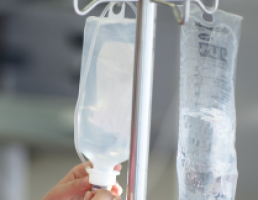
New research concludes that patients with limited-stage Hodgkin lymphoma treated with a standard chemotherapy regimen have better overall survival rates compared with those receiving a radiation-based treatment.
Patients with limited-stage Hodgkin lymphoma (HL) are often treated with combination therapy containing chemotherapy plus radiation (RT). While this therapy is successful in controlling HL, these patients remain challenged by potential long-term complications of radiation exposure such as heart conditions or subsequent cancers.
To determine if HL patients treated with standard chemotherapy (ABVD) have better long-term survival than those treated with radiation-based therapy, researchers from Canada's NCIC Clinical Trials Group (NCIC CTG) designed a trial comparing the 12-year overall survival (OS) between the two groups. The Eastern Cooperative Oncology Group (ECOG) also participated in the trial. Along with overall survival, the trial also examined secondary survival factors, including freedom from disease progression (FFDP) and event-free survival (EFS).
Approximately 400 patients with non-bulky (small tumor size) clinical stage I-IIA HL were stratified into low- and high-risk groups and randomized into two treatment arms: those who received ABVD and those who received extended-field RT (with or without ABVD).
By comparing survival rates of the two treatment arms, researchers found that at 12 years, participants treated with ABVD had better OS (94%) than those treated with radiation-based therapy (87%). However, patients treated with RT had better FFDP than those who were randomized to ABVD alone, a finding that was aligned with previous results of short-term success rates using RT. Researchers did not find a significant difference in EFS between the groups.
When analyzing results specifically for high-risk patients, who may carry a poorer prognosis, the findings were generally similar to the primary analysis, with higher OS rates observed in the ABVD treatment arm group (92%) when compared to the ABVD plus RT group (81%). Late effects of treatment, such as heart conditions or secondary cancers, were also less frequent in patients treated with ABVD alone.
“The results of our study suggest that in the long-term patients with limited-stage HL may be better served by a treatment approach that uses chemotherapy without radiation, as this method seems to be associated with fewer deaths from other causes,” said lead author Ralph M. Meyer, MD, Director of the NCIC CTG. “After 12 years of follow-up, we have gained valuable and reliable insights about the long-term value of specific therapeutic interventions to help clinicians make more informed treatment decisions and better manage the possible risks for their patients.”
Source: ASH